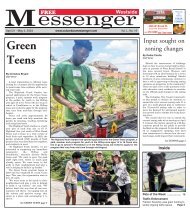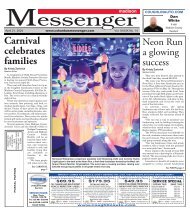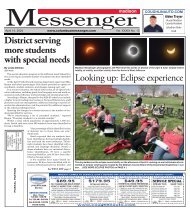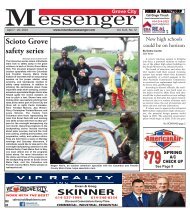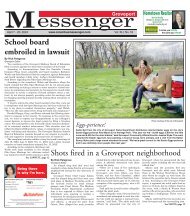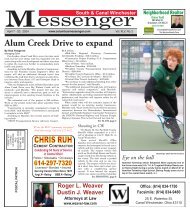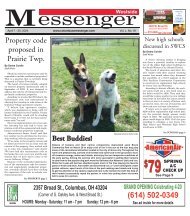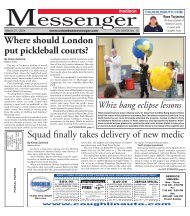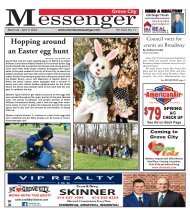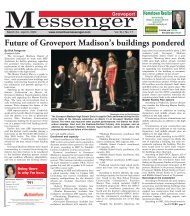Madison Messenger - April 19th, 2020
Create successful ePaper yourself
Turn your PDF publications into a flip-book with our unique Google optimized e-Paper software.
PAGE 10 - MADISON MESSENGER - <strong>April</strong> 19, <strong>2020</strong><br />
www.madisonmessengernews.com<br />
Expand your native plant palette with nativars<br />
By Teresa Woodard<br />
Blogger at www.Heartland-gardening.com<br />
Flopping grasses, no-show flowers and<br />
unruly plants.<br />
Many home gardeners say “no thanks” to<br />
such “wild” native plants for these reasons<br />
and others. But, thanks to the flourishing<br />
native plant movement, the market has responded<br />
with a new and improved plant<br />
palette of “nativars.” It’s an industry buzzword<br />
for selected, hybridized, or crossbred<br />
varieties of native plants that offer more<br />
compact sizes, cleaner foliage, better color,<br />
or tidier appearance, especially for home<br />
landscapes.<br />
Nativars like “Standing Ovation” little<br />
bluestem and “Magnus” coneflower offer<br />
many of the eco-benefits of their straightspecies<br />
cousins but behave better in the<br />
home landscape.<br />
A bonus is these nativars are more<br />
widely available through garden centers<br />
and big box stores, unlike native plants that<br />
often are exclusively sold through specialty<br />
growers or occasional native plant sales.<br />
More nativars seems to be a plus for pollinators,<br />
but some purists say that nativars<br />
don’t equally benefit insects and birds like<br />
straight-species natives. Research shows<br />
not all nativars are equally beneficial when<br />
it comes to pollinator appeal. For example,<br />
a change in leaf color or flower shape may<br />
dissuade pollinators. Several trial gardens<br />
across the country are taking a closer look.<br />
At Mount Cuba Center in Delaware, the<br />
botanical garden’s team trialed 66 varieties<br />
of garden phlox (Phlox paniculata which is<br />
native to much of the eastern United States)<br />
and found the mildew-resistant nativar<br />
Phlox paniculata “Jeana” was a winner with<br />
530 butterfly visits. They also trialed 40<br />
Monarda selections and named two nativar<br />
winners—Monarda fistulosa “Claire Grace”<br />
and Monarda didyma “Jacob Cline.” See<br />
https://mtcubacenter.org/research/trial-garden/<br />
for a complete list. Penn State, Chicago<br />
Botanic Gardens and the Cincinnati Zoo &<br />
Botanical Gardens also are conducting nativar<br />
pollinator plant trials.<br />
The bottom line for me is that nativars<br />
are making a positive impact for their<br />
beauty, ease of care, accessibility and ecological<br />
integrity. The more variety of natives<br />
and nativars you can bring to your backyard,<br />
the better. So, when shopping for new<br />
plants this spring, give nativars a try. Plant<br />
a few (see 10 favorites below), run your own<br />
experiments and watch to see if pollinators<br />
show up. Even consider sharing your results<br />
with the Chicago Botanic Garden’s Bud-<br />
Burst citizen science research project.<br />
• Little bluestem (Schizachyrium<br />
“Standing Ovation”)<br />
• Coneflower (echinacea purpurea<br />
“White Swan” and “Ruby Star”)<br />
• Joe Pye weed (“Baby Joe” Eupatorium)<br />
• Giant hyssop (Agastache “Blue Fortune”)<br />
• Aster (Aster “October Skies”)<br />
• Garden phlox (Phlox paniculata<br />
“Jeana”)<br />
• Beebalm (Monarda “Jacob Cline”)<br />
• Goldenrod (Solidago rugosa “Fireworks”)<br />
• False indigo (Baptisia “Purple Smoke”)<br />
• Penstemon (Penstemon digitalis<br />
“Husker Red”).<br />
In spite of what their name suggests, bed<br />
bugs can be found in places other than beds.<br />
While bed bugs are most often found in beds<br />
where they can feast on people while they<br />
sleep, they also can be found on anything<br />
that’s upholstered. That includes chairs and<br />
couches but also curtains and carpets. Bed<br />
“Nativars” offer more compact sizes,<br />
cleaner foliage, better color, and/or tidier<br />
appearances that work well in home landscapes.<br />
Bed bugs lurk beyond the covers<br />
bugs also may be lurking behind dressers or<br />
beneath beds. Some might even be hiding behind<br />
beds by attaching themselves to headboards.<br />
Bed bugs also can attach to clothing,<br />
which is how bed bug infestations in public<br />
places like movie theaters can quickly turn<br />
into bed bug infestations at home.




